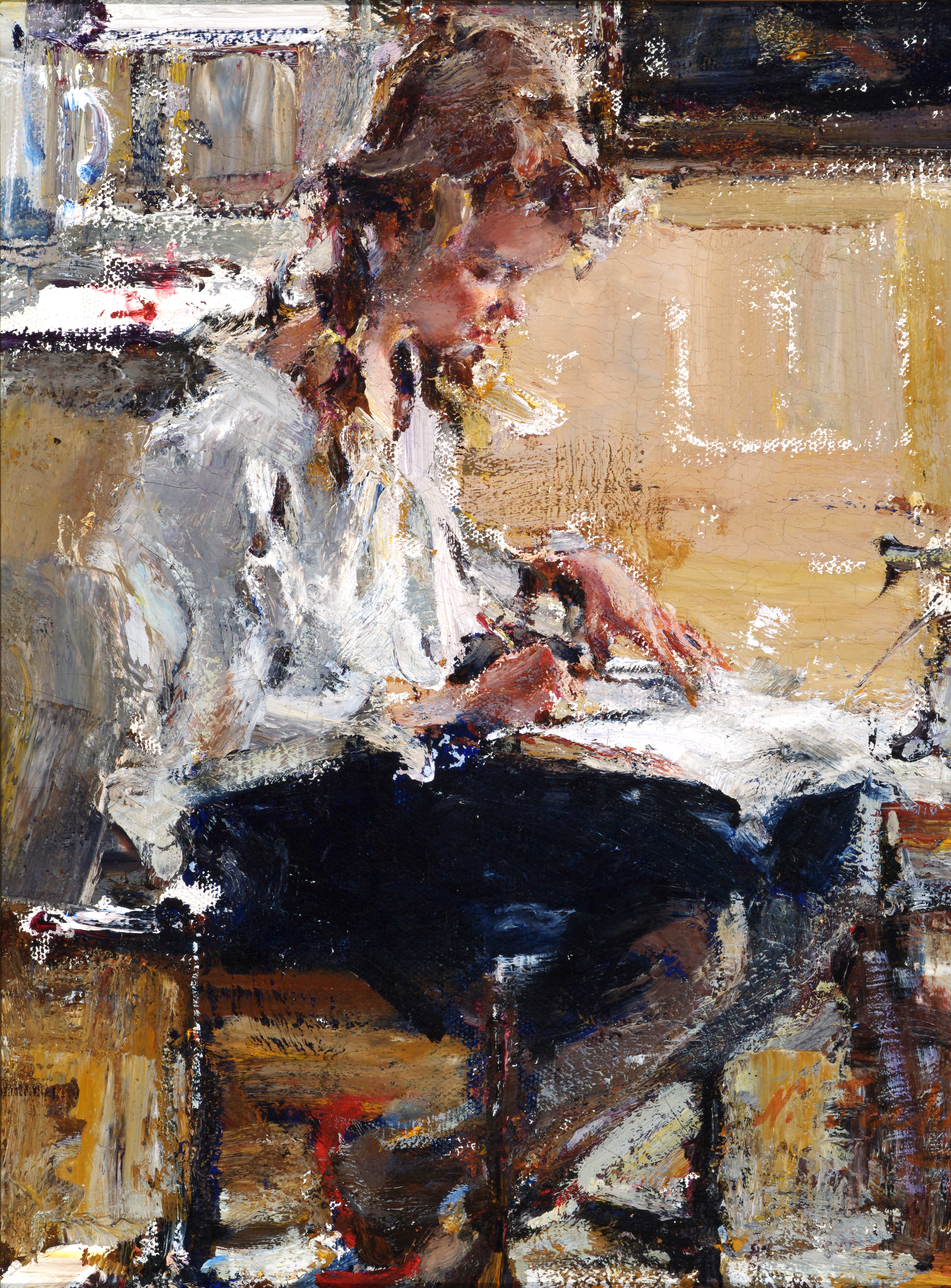Docents at The Hermitage have the opportunity to participate in ongoing collections-based research. Docents work alongside the Curator of Collections on a topic of their choice, often drawing from original source material and rare documents in the Hermitage archives. Research is presented monthly at our lively ‘Docent Weiterbildung’ (German for “continuance of one’s education”), and will ultimately be incorporated into an online collections database.

Nikolai Fechin’s Girl Drawing by Sevda Basar
The Sloane family hosted many artists in their house over the years. Unfortunately, they were not able host Nicolai Fechin at the Hermitage, according to the Museum’s archival documents. However, the Hermitage Museum does have the work Girl Drawing by Fechin as part of its permanent collection.
Girl Drawing is an oil painting on canvas, signed by Nicolai Fechin. This attractive work by Fechin was bought for Mrs. Florence Knapp Sloane from Grand Central Gallery in New York City in 1926.
Fechin was known as a master of the portrait. He painted his many portraits in alla prima fashion. Fechin used seemingly nervous brush strokes in his paintings, and they appear to have been made in hurry. Unlike his contemporaries, Fechin made his own absorbent ground out of casein. The casein absorbed enough oil to allow the paint to ‘set up’ quickly and give the brush strokes a dry appearance in the paintings. In order to prepare his palette, Fechin also squeezed the paint onto newspaper first, allowing it to absorb much of the oil.
Hung in the Central Hall of the Hermitage Museum, Girl Drawing exemplifies Fechin’s artistic features and skills. When I first saw the painting, I was surprised with the differences in the use of paint between the face, hands, and the rest of the portrait; except for the hands and face, the surface of the painting looks like it was painted by a child. However, this encrusted appearance of the surface makes the smoothly painted hands and face of the girl more significant.
Girl Drawing, considered one of Fechin’s best works, was borrowed by the Fechin Institute in Taos, New Mexico in 1987 for the seventh annual exhibition of Fechin’s works. It was requested via letter by Eya Fechin Branham, daughter of the painter. This letter is preserved in the Hermitage’s archives.
Biography
The artist Nicolai Fechin was born in 1881 in the small village of Kazan, Russia. At the age of thirteen, he entered the Kazan School of Art. In 1900, Fechin was tested and accepted to the Imperial Academy of Petrograd. The style that influenced him most was that of a former Academy professor, Malavin, who was known for his use of “wide, nervous brushstrokes”. The advanced students were left to their own devices. Fechin, the most accomplished of the students, improved himself while becoming more and more fascinated with portraits.
At the end of his education in the Academy, Fechin earned a position at the Kazan School of Art as an instructor. In 1909, he graduated with the highest possible grade and his works were awarded with the Prix de Rome, a travelling scholarship enabling him to visit the artistic capitals of Europe in 1910. In that same year, he also presented his first exhibitions in America. He sent his painting Madame Sapojnikova to an international exhibition at the Carnegie Institute in Pittsburgh where it was purchased by W.S. Stimmel.
After his travels he resumed his work at the Kazan School of Art and taught for the next decade. He married the daughter of the School’s Director in 1913.
Shortly after the Bolshevik Revolution, Fechin, his wife Alexandra, and his daughter Eya emigrated to the United States. When Fechin arrived in New York in 1923 he was already well-known for his canvases. His work was featured in traveling exhibitions in America for over ten years prior to his arrival. In fact, it was American friends and patrons, especially Stimmel, who helped Fechin and his family to leave Russia. There was a significant demand for Fechin’s paintings and he won first prize at the Academy in New York in 1924 as well as a medal at the 1926 International Exposition in Philadelphia.
Fechin developed tuberculosis in New York and it was suggested he move to a dryer climate. He visited Taos, New Mexico in 1926 and moved there permanently in 1927. In Taos he built a house, considered a work of architectural art, and used it as the base for the Fechin Institute, a non-profit cultural organization formed in 1981.
In 1927, Fechin left Taos after divorcing his wife. Following a brief visit to New York with his daughter, he moved to California after an invitation from Earl Stendahl, a Los Angeles art dealer, to participate in several art shows and to teach classes. For the next ten years, Fechin and Eya lived near each other in the Hollywood Hills.
From California, Fechin traveled to Mexico, Japan, Java, and Bali; the latter he loved and spent considerable time exploring. Unfortunately, the damp climate made him ill.


